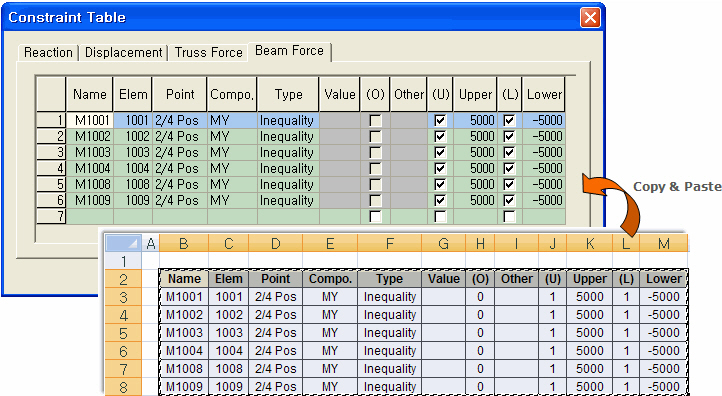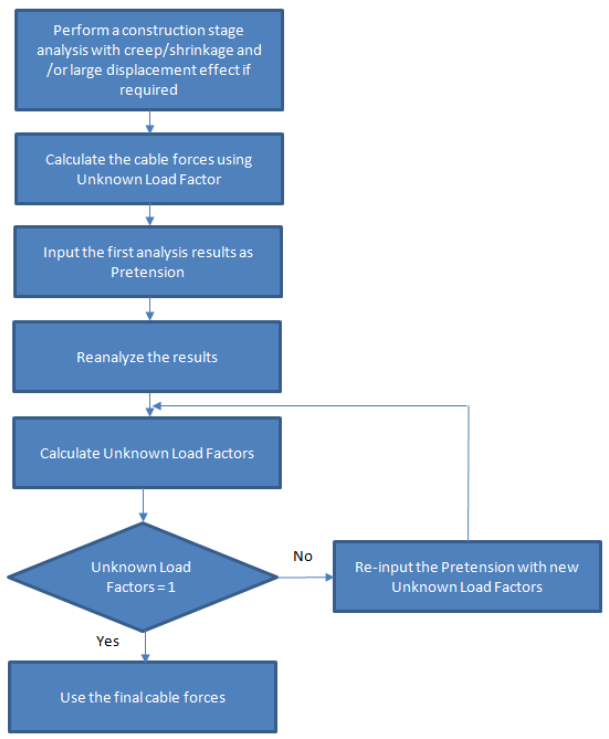Unknown Load Factor
Use optimization techniques or combine equations to determine the optimal load factors that satisfy the specific constraints of a structure.
This function optimizes tensions of cables at the initial equilibrium position of a cable structure. The program can calculate the initial cable force by inputting the restrictions such as displacement, moment, etc. and satisfying the constraints.
From the Main Menu select Results > Bridge > Cable Control > Unknown Load Factor.
In order to calculate unknown load factors using optimization techniques, load combinations, load cases pertaining to the unknown load factors, specific constraints and object functions are required. All these data are collected in a unique and unknown load factor group for analysis. Several groups can be formulated where they can be saved, modified or deleted.
Note
The unknown load factors obtained by using the Unknown Load Factor feature for the final stage model do not include the change in stiffness of the cable due to the change in pretension and hence the user must perform iterations to determine the pretension in the cables to satisfy constrains. The following procedure can be adopted:
1. Define the constraints and obtain the Unknown Load Factors for the Cable Pretension Forces.
2. Determine the Cable Pretension Force by multiplying those factors with the assigned Cable Forces
3. Change the Cable Pretension Forces with the new ones ( obtained in step 2)
4. Perform the Analysis.
5. Check whether the constraints are satisfied with modified pretensions
6. If not then determine the Unknown load factors again and keep repeating steps 2 to 5 till you get the constraints satisfied after static analysis ( step 5)
![]()
Click Add New to create a new Unknown Load Factor Group by specifying the conditions to obtain the unknown load factor.
![]()
Modify a previously created Unknown Load Factor Group.
![]()
Delete a previously created Unknown Load Factor Group.
When a new Unknown Load Factor Group is created by clicking ![]() or when a group is modified by clicking
or when a group is modified by clicking ![]() , enter or modify the data in Unknown Load Factor Detail shown below.
, enter or modify the data in Unknown Load Factor Detail shown below.
Item Name: Enter the name of the Unknown Load Factor Group.
Load Comb: Select a load combination from the previously entered load combinations in "Results>Combinations" to calculate the unknown load factors. The load combination used to calculate the unknown load factors must include the load cases that form the basis of the load factors.
In the latest version of midas Civil, the numbers of loads are limited to 150 in each load combination. Therefore, if the load conditions to determine the Unknown Load Factors exceed 150, then the conditions should be divided into two or more combinations, each less than 150 load cases, and each combination should be defined. The load combinations should then be grouped, and the group should be selected as another load combination.
Object Function type: Select the method of forming an object function consisted of unknown load factors.
Linear: The sum of the absolute values of Load factor x scale factor
![]()
Square: The linear sum of the squares of Load factor x scale factor
![]()
Max Abs: The maximum of the absolute values of Load factor x scale factor
![]()
Sign of Unknowns: Assign the sign of the unknown load factors to be calculated.
Negative: Limit the range of the calculated values to the negative (-) field.
Both: Do not limit the range of the calculated values.
Positive: Limit the range of the calculated values to the positive (+) field.
Unknown: Check in the load case for which the unknown load factor is to be obtained. When load cases are activated as unknown load factors, the character "Unknown" appears in the Factor field of the relevant load case.
LCase: The name of the load case to be used as an unknown load factor.
Weighted Factor: Weighted Factors are scale factors that control the relative importance of the unknown load factors in the object functions.
Constraints: Enter the constraints to be satisfied by the load combination results that include the unknown load factors. When specifying the constraints, a list of constraints is created. The constraints may be selectively applied. The constraint types are displacement, reaction and member force for the truss or beam element.
![]() : Select to create a new constraint.
: Select to create a new constraint.
![]() : Select to modify a previously entered constraint.
: Select to modify a previously entered constraint.
![]() : Select to delete a previously entered constraint.
: Select to delete a previously entered constraint.
![]() : Enter and modify the constraint data easily and quickly using the table. Copy and paste constraint data from an excel file is also available.
: Enter and modify the constraint data easily and quickly using the table. Copy and paste constraint data from an excel file is also available.

![]() When
When ![]() or
or ![]() is selected.
is selected.
Constraint Name: Specify the constraint name
Constraint Type: Specify the constraint type
![]() Simultaneous Equations method
Simultaneous Equations method
Unknown Load Factor function finds the solution, out of many solutions, which will give the least value of object function. This algorithm is good for simultaneous inequality but not good for simultaneous equations. Sometimes it took a long time to find a solution. Therefore, Simultaneous Equation Method has been implemented to improve this problem. It is recommended to use this method in case when the number of constraints (Equations) and unknown load factors are the same.
![]()
This tab calculates the selected Unknown Load Factors by using the constraints. It calculates the unknown load factors that minimizes the restricted functions and shows the result as follows.
Factor: Calculated unknown load factors
Value: Resulting values of the constraints
Upper Bound: Upper bound of each constraint
Lower Bound: Lower bound of each constraint
Influence Matrix: The calculated results of Unknown Load Factors are produced including Influence Matrix.
![]() : Load combinations ard automatically generated by using the calculated Unknown Load Factors.
: Load combinations ard automatically generated by using the calculated Unknown Load Factors.
![]()
The calculated results of Unknown Load Factors including Influence Matrix are produced in an Excel file.

Results of Unknown Load Factors converted into an Excel file
Note
In the converted Excel file, we can find unknown load factors satisfying desired constraints by changing the unknown load factors, which change the constraints.
![]() Functionality of Unknown Load Factor considering construction stage
Functionality of Unknown Load Factor considering construction stage
